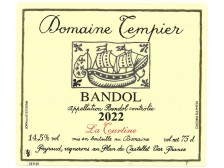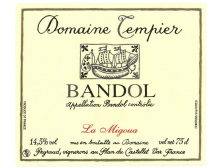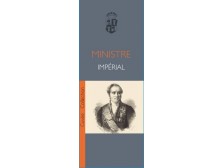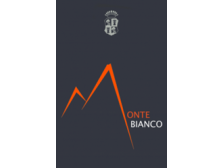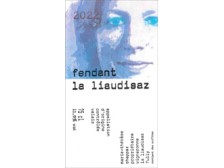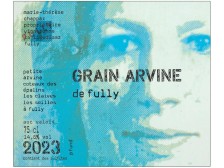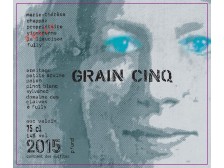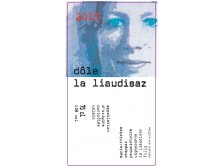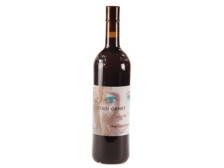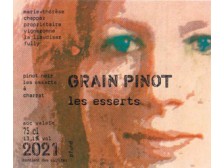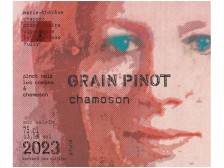Catalog
-
An iconic and historic Bandol estate, in the hands of the Tempier family for nearly 2 centuries. It was Lucien Peyraud, husband of Lucie Tempier, who, from 1945 onwards and as President of Bandol wines, fought to impose Mourvèdre (minimum 50%) in the appellation. Despite their natural concentration and power, the estate's reds are distinguished, refined and harmonious, with an ageing potential worthy of the greatest Rhône wines.
Rated three stars in the Revue du Vin de France guide.
Cuvée Lulu et Lucien, named after the Tempier family's forebears, is the estate's classic cuvée, a blend of the estate's different terroirs (the famous 'restanques', clay-limestone terraces overlooking the Mediterranean), vines aged 30 years or more, 75% Mourvèdre.The 2023 vintage in the press:
La Revue du Vin de France (Guide 2026) : "Lulu et Lucien (named in honour of the estate's founders) is an entry-level cuvée with the depth typical of Bandol. Bright fruitiness and a texture that reveals perfect balance in 2023."
More- To keep or to drink:
- Wait 5 to 10 years
- Apogée:
- 2030-2042
-
An iconic and historic Bandol estate, in the hands of the Tempier family for nearly 2 centuries. It was Lucien Peyraud, husband of Lucie Tempier, who, from 1945 onwards and as President of Bandol wines, fought to impose Mourvèdre (minimum 50%) in the appellation. Despite their natural concentration and power, the estate's reds are distinguished, refined and harmonious, with an ageing potential worthy of the greatest Rhône wines.
Rated three stars in the Revue du Vin de France guide.
Cuvée Lulu et Lucien, named after the Tempier family's forebears, is the estate's classic cuvée, a blend of the estate's different terroirs (the famous 'restanques', clay-limestone terraces overlooking the Mediterranean), vines aged 30 years or more, 75% Mourvèdre.The 2022 vintage in the press:
La Revue du Vin de France (Guide 2025): 94/100 Coup de ♥ “Lulu et Lucien (in homage to the estate's founders) is a lacy entry-level cuvée: delicate nose, harmonious palate, overall finesse.”
More- To keep or to drink:
- Wait 3 to 5 years
- Apogée:
- 2028-2042
-
An iconic and historic Bandol estate, in the hands of the Tempier family for nearly 2 centuries. It was Lucien Peyraud, husband of Lucie Tempier, who, from 1945 onwards and as President of Bandol wines, fought to impose Mourvèdre (minimum 50%) in the appellation. Despite their natural concentration and power, the estate's reds are distinguished, refined and harmonious, with an ageing potential worthy of the greatest Rhône wines.
Rated three stars in the Revue du Vin de France guide.La Tourtine, 85% Mourvèdre aged 50 years, is the best synthesis of their parcel-based cuvées, more full-bodied and robust than La Migoua, finer than Cabassaou.
The 2023 vintage in the press:
La Revue du Vin de France (Guide 2026): 97/100 “La Tourtine showcases all the exceptional qualities of the Bandol terroir. Noble tannins, radiant and flavourful fruit, beautiful intensity.”
More- To keep or to drink:
- Wait 5 to 10 years
- Apogée:
- 2033-2050
-
An iconic and historic estate in Bandol, owned by the Tempier family for nearly two centuries. It was Lucien Peyraud, husband of Lucie Tempier, who, from 1945 onwards and as President of Bandol wines, fought to impose Mourvèdre (minimum 50%) in the appellation. Despite their natural concentration and power, the estate's reds manage to remain distinguished, refined and harmonious, while possessing a ageing potential worthy of the greatest Rhône wines.
Rated three stars in the Guide de la Revue du Vin de France.
La Migoua, only 55% Mourvèdre (complemented by Cinsault, Grenache and Syrah), is the estate's highest altitude single vineyard cuvée. It is also the freshest and most elegant, with an unrivalled velvety texture.
The 2023 vintage in the press:
La Revue du Vin de France (Guide 2026): 95/100 “La Migoua, composed of half Mourvèdre, offers warm fruit (cherry) with perfect sweetness. Intensity and volume on the finish.”
More- To keep or to drink:
- Wait 5 to 10 years
- Apogée:
- 2031-2045
-
With a priceless ampelographic collection built up by his father Antoine in the 1960s, Jean-Charles Abbatucci is the guardian of the endemic grape varieties and wine-making traditions of Corsica. This variety of grapes (with melodious names: Carcajolo Bianco, Paga Debbiti, Rossola Brandinca...) coupled with a sumptuous terroir of 14 ha full hillside south of Ajaccio and a demanding viticulture (biodynamic since 2000) explains the special place of Domaine Abbatucci within the Corsican producers. It is with the white wines, certainly among the most beautiful of the Mediterranean basin, that this domain has built up an unequalled reputation.
The first cuvée Faustine, 100% vermentino, is a direct entry into the Abbatucci universe: floral (aniseed) and delicately apricot on the nose, supple (without any heaviness) and elegant on the palate, with a fine bitterness on the finish.
Rated three stars in the Revue du Vin de France's annual guide.
The 2024 vintage in the press:
La Revue du Vin de France (Guide 2026): 91/100 “The Vermentinu, with its refined, aniseed profile, gains breadth with time.”
More- To keep or to drink:
- Ready to drink
- Apogée:
- 2023-2028
-
With a priceless ampelographic collection built up by his father Antoine in the 1960s, Jean-Charles Abbatucci is the guardian of the endemic grape varieties and wine-making traditions of Corsica. This variety of grapes (with melodious names: Carcajolo Bianco, Paga Debbiti, Rossola Brandinca...) coupled with a sumptuous terroir of 14 ha full hillside south of Ajaccio and a demanding viticulture (biodynamic since 2000) explains the special place of Domaine Abbatucci within the Corsican producers. It is with the white wines, certainly among the most beautiful of the Mediterranean basin, that this domain has built up an unequalled reputation.
The first cuvée Faustine, 100% vermentino, is a direct entry into the Abbatucci universe: floral (aniseed) and delicately apricot on the nose, supple (without any heaviness) and elegant on the palate, with a fine bitterness on the finish.
Rated three stars in the Revue du Vin de France's annual guide.
The 2023 vintage in the press:
La Revue du Vin de France (Guide 2025): 92/100 “Svelte and uncluttered, the white is dynamic and mineral.”
More- To keep or to drink:
- Ready to drink
- Apogée:
- 2023-2028
-
With a priceless ampelographic collection built up by his father Antoine in the 1960s, Jean-Charles Abbatucci is the guardian of the endemic grape varieties and wine-making traditions of Corsica. This variety of grapes (with melodious names: Carcajolo Bianco, Paga Debbiti, Rossola Brandinca...) coupled with a sumptuous terroir of 14 ha full hillside south of Ajaccio and a demanding viticulture (biodynamic since 2000) explains the special place of Domaine Abbatucci within the Corsican producers. It is with the white wines, certainly among the most beautiful of the Mediterranean basin, that this domain has built up an unequalled reputation.
The first cuvée Faustine, 100% vermentino, is a direct entry into the Abbatucci universe: floral (aniseed) and delicately apricot on the nose, supple (without any heaviness) and elegant on the palate, with a fine bitterness on the finish.
Rated three stars in the Revue du Vin de France's annual guide.
Rated 92/100 by La Revue du Vin de France "This cuvée was made in 1998 when my daughter Faustine was born. It is a 100% vermentino planted on granite arena. A brilliantly coloured wine with lots of freshness and minerality. Ideal with fish or white meats." (January 2024)
More- To keep or to drink:
- Ready to drink
- Apogée:
- 2023-2028
-
With a priceless ampelographic collection built up by his father Antoine in the 1960s, Jean-Charles Abbatucci is the guardian of the endemic grape varieties and wine-making traditions of Corsica. This variety of grapes (with melodious names: Carcajolo Bianco, Paga Debbiti, Rossola Brandinca...) coupled with a sumptuous terroir of 14 ha full hillside south of Ajaccio and a demanding viticulture (biodynamic since 2000) explains the special place of Domaine Abbatucci within the Corsican producers. It is with the white wines, certainly among the most beautiful of the Mediterranean basin, that this domain has built up an unequalled reputation.
Rated three stars in the Revue du Vin de France guide.
One of the two great vintages of the domain, dominated by vermentino and supplemented by 10 autochthonous grape varieties in varying proportions, is an exceptional wine with good ageing potential (10 years and more): the Diplomate is full-bodied, sapid and tasty but restrained. For this wine the whole aromatic palette of the Corsican scrubland: citrus fruits (citron, kumquat...), verbena, thyme, rosemary, fennel, anise, wild mint, jasmine, pine nuts, dry stones...
More- To keep or to drink:
- Wait 1 to 2 years
- Apogée:
- 2026-2036
-
With a priceless ampelographic collection built up by his father Antoine in the 1960s, Jean-Charles Abbatucci is the guardian of the endemic grape varieties and wine-making traditions of Corsica. This variety of grapes (with melodious names: Carcajolo Bianco, Paga Debbiti, Rossola Brandinca...) coupled with a sumptuous terroir of 14 ha full hillside south of Ajaccio and a demanding viticulture (biodynamic since 2000) explains the special place of Domaine Abbatucci within the Corsican producers. It is with the white wines, certainly among the most beautiful of the Mediterranean basin, that this domain has built up an unequalled reputation.
Rated three stars in the Revue du Vin de France guide.
One of the two great vintages of the domain, dominated by vermentino and supplemented by 10 autochthonous grape varieties in varying proportions, is an exceptional wine with good ageing potential (10 years and more): the Diplomate is full-bodied, sapid and tasty but restrained. For this wine the whole aromatic palette of the Corsican scrubland: citrus fruits (citron, kumquat...), verbena, thyme, rosemary, fennel, anise, wild mint, jasmine, pine nuts, dry stones...
More- To keep or to drink:
- Wait 1 to 2 years
- Apogée:
- 2026-2036
-
With a priceless ampelographic collection built up by his father Antoine in the 1960s, Jean-Charles Abbatucci is the guardian of the endemic grape varieties and wine-making traditions of Corsica. This variety of grapes (with melodious names: Carcajolo Bianco, Paga Debbiti, Rossola Brandinca...) coupled with a sumptuous terroir of 14 ha full hillside south of Ajaccio and a demanding viticulture (biodynamic since 2000) explains the special place of Domaine Abbatucci within the Corsican producers. It is with the white wines, certainly among the most beautiful of the Mediterranean basin, that this domain has built up an unequalled reputation.
Rated three stars in the Revue du Vin de France guide.
One of the two great vintages of the domain, dominated by vermentino and supplemented by 10 autochthonous grape varieties in varying proportions, is an exceptional wine with good ageing potential (10 years and more): the Diplomate is full-bodied, sapid and tasty but restrained. For this wine the whole aromatic palette of the Corsican scrubland: citrus fruits (citron, kumquat...), verbena, thyme, rosemary, fennel, anise, wild mint, jasmine, pine nuts, dry stones...
The 2021 vintage is rated 93-94/100 by the Revue du Vin de France « Des parfums accueillants et frais de fenouil, de cédrat forment un ensemble cristallin, pur et frais, noblement boisé. La bouche offre à la fois une trame mûre et tonique, sans oublier une belle énergie et salinité. »
More- To keep or to drink:
- Wait 1 to 2 years
- Apogée:
- 2026-2036
-
With a priceless ampelographic collection built up by his father Antoine in the 1960s, Jean-Charles Abbatucci is the guardian of the endemic grape varieties and wine-making traditions of Corsica. This variety of grapes (with melodious names: Carcajolo Bianco, Paga Debbiti, Rossola Brandinca...) coupled with a sumptuous terroir of 14 ha full hillside south of Ajaccio and a demanding viticulture (biodynamic since 2000) explains the special place of Domaine Abbatucci within the Corsican producers. It is with the white wines, certainly among the most beautiful of the Mediterranean basin, that this domain has built up an unequalled reputation.
Rated three stars in the Revue du Vin de France guide.
One of the two great vintages of the estate, with a dominant vermentino complemented by 10 autochthonous grape varieties in varying proportions, is an exceptional wine with good aging capacities (10 years and more): the General is more lively, its tension going hand in hand with its sparkling length. For this wine the whole aromatic palette of the Corsican scrubland: citrus fruits (citron, kumquat...), verbena, thyme, rosemary, fennel, anise, wild mint, jasmine, pine nuts, dry stones...
The 2023 vintage in the press:
La Revue du Vin de France (Guide 2026): 94/100 Coup de ♥ "Général de la Révolution reveals a complex, balanced, perfectly matured white wine, aged on its lees for nine months, a mosaic of six grape varieties."
Bettane + Desseauve (Guide 2026) : 94/100
More- To keep or to drink:
- Wait 3 to 5 years
- Apogée:
- 2025-2035
-
With a priceless ampelographic collection built up by his father Antoine in the 1960s, Jean-Charles Abbatucci is the guardian of the endemic grape varieties and wine-making traditions of Corsica. This variety of grapes (with melodious names: Carcajolo Bianco, Paga Debbiti, Rossola Brandinca...) coupled with a sumptuous terroir of 14 ha full hillside south of Ajaccio and a demanding viticulture (biodynamic since 2000) explains the special place of Domaine Abbatucci within the Corsican producers. It is with the white wines, certainly among the most beautiful of the Mediterranean basin, that this domain has built up an unequalled reputation.
Rated three stars in the Revue du Vin de France guide.
Light ruby in color, airy and delicate on the palate, superlative freshness, silky tannins: all the magic of high-altitude sciaccarellu (with a few vines of old autochthonous varieties) is expressed in the Ministre Impérial cuvée, grown on granite soil and picked at optimum ripeness, with an almost Burgundian profile. A great wine!
The 2023 vintage in the press:
La Revue du Vin de France (Guide 2026) : 93/100
More- To keep or to drink:
- Wait 3 to 5 years
- Apogée:
- 2029-2042
-
With a priceless ampelographic collection built up by his father Antoine in the 1960s, Jean-Charles Abbatucci is the guardian of the endemic grape varieties and wine-making traditions of Corsica. This variety of grapes (with melodious names: Carcajolo Bianco, Paga Debbiti, Rossola Brandinca...) coupled with a sumptuous terroir of 14 ha full hillside south of Ajaccio and a demanding viticulture (biodynamic since 2000) explains the special place of Domaine Abbatucci within the Corsican producers. It is with the white wines, certainly among the most beautiful of the Mediterranean basin, that this domain has built up an unequalled reputation.
Rated three stars in the Revue du Vin de France guide.
Light ruby in color, airy and delicate on the palate, superlative freshness, silky tannins: all the magic of high-altitude sciaccarellu (with a few vines of old autochthonous varieties) is expressed in the Ministre Impérial cuvée, grown on granite soil and picked at optimum ripeness, with an almost Burgundian profile. A great wine!
More- To keep or to drink:
- Wait 1 to 2 years
- Apogée:
- 2027-2038
-
With a priceless ampelographic collection built up by his father Antoine in the 1960s, Jean-Charles Abbatucci is the guardian of the endemic grape varieties and wine-making traditions of Corsica. This variety of grapes (with melodious names: Carcajolo Bianco, Paga Debbiti, Rossola Brandinca...) coupled with a sumptuous terroir of 14 ha full hillside south of Ajaccio and a demanding viticulture (biodynamic since 2000) explains the special place of Domaine Abbatucci within the Corsican producers. It is with the white wines, certainly among the most beautiful of the Mediterranean basin, that this domain has built up an unequalled reputation.
Rated three stars in the Revue du Vin de France guide.
Monte Bianco, his greatest red wine, with its light ruby colour, its airy and delicate palate, its superlative freshness and silky tannins, offers all the magic of high altitude sciaccarellu on granitic soil and harvested at optimal maturity. A really great wine!
The 2023 vintage in the press:
La Revue du Vin de France (Guide 2026): 93/100 "Monte Bianco, although warm, seduces with its energy and the finesse of the sciaccarellu."
Bettane + Desseauve (Guide 2026) : 96/100
More- To keep or to drink:
- Wait 1 to 2 years
- Apogée:
- 2027-2038
-
Young and passionate winegrower, Alexandre Delétraz created the Cave des Amandiers in 2008 on the small steep terraces of Fully overlooking the Swiss Rhone Valley, between 400 and 900 m of altitude. This is an ideal terroir for the expression of Petite Arvine (a magnificent white grape variety native to the Valais) and Syrah (as in the French Northern Rhône Valley). "A heroic viticulture. The wines have gained in precision consecrating the estate among the stars of the region" for the Revue du Vin de France.
The two facets of Petite Arvine: crystalline and tense on the granitic terroir of Seyes, rounder and deeper on the Rhone alluvium of the Saillon terroir, down below.
More- To keep or to drink:
- Ready to drink
- Apogée:
- 2025-2030
-
Young and passionate winegrower, Alexandre Delétraz created the Cave des Amandiers in 2008 on the small steep terraces of Fully overlooking the Swiss Rhone Valley, between 400 and 900 m of altitude. This is an ideal terroir for the expression of Petite Arvine (a magnificent white grape variety native to the Valais) and Syrah (as in the French Northern Rhône Valley). "A heroic viticulture. The wines have gained in precision consecrating the estate among the stars of the region" for the Revue du Vin de France.
The two facets of Petite Arvine: crystalline and tense on the granitic terroir of Seyes, rounder and deeper on the Rhone alluvium of the Saillon terroir, down below.More- To keep or to drink:
- Wait 1 to 2 years
- Apogée:
- 2025-2030
-
Young and passionate winegrower, Alexandre Delétraz created the Cave des Amandiers in 2008 on the small steep terraces of Fully overlooking the Swiss Rhone Valley, between 400 and 900 m of altitude. This is an ideal terroir for the expression of Petite Arvine (a magnificent white grape variety native to the Valais) and Syrah (as in the French Northern Rhône Valley). "A heroic viticulture. The wines have gained in precision consecrating the estate among the stars of the region" for the Revue du Vin de France.
With a classic Côte-Rôtie nose (red fruits and violet), this fresh, juicy and refined Syrah finishes with the peppery notes so characteristic of the grape variety.
More- To keep or to drink:
- Wait 1 to 2 years
- Apogée:
- 2027-2035
-
In 20 years, Ms Chappaz has become Switzerland's emblematic winemaker, following the example of Ms Bize-Leroy in Burgundy. In her 10-hectare vineyard on the south-facing slopes of Fully, she strives to give full expression to the typicity and authenticity of each grape variety through ultra-careful viticulture (biodynamic since 2003).
More- To keep or to drink:
- Ready to drink
- Apogée:
- 2024-2029
-
In 20 years (first vintage in 1988), Mrs. Chappaz has become the emblematic winemaker of Switzerland, following the example of Mrs. Bize-Leroy in Burgundy. In her 10 ha vineyard on the southern slopes of Fully, she tries to express the typicity and authenticity of each grape variety by an ultra careful viticulture (biodynamic since 2003).
Fendant Côteau de Plamont: parcel wine in Fully, 100% chasselas on "red earth" (loess on granite)More- To keep or to drink:
- Ready to drink
- Apogée:
- 2024-2029
-
In 20 years, Ms Chappaz has become Switzerland's emblematic winemaker, following the example of Ms Bize-Leroy in Burgundy. In her 10-hectare vineyard on the south-facing slopes of Fully, she strives to give full expression to the typicity and authenticity of each grape variety through ultra-careful viticulture (biodynamic since 2003).
More- To keep or to drink:
- Ready to drink
- Apogée:
- 2025-2031
-
In 20 years, Mrs Chappaz has become the emblematic winemaker of Switzerland, like Mrs Bize-Leroy in Burgundy. In its 10 ha vineyard on the south-facing slopes of Fully, it seeks to express as well as possible the typicity and authenticity of each grape variety through ultra attentive viticulture (biodynamic since 2003).
Grain Arvine : Several plots, 100% small arvine aged 15 years, matured in vats.More- To keep or to drink:
- Ready to drink
- Apogée:
- 2025-2031
-
In 20 years (first vintage in 1988), Mrs Chappaz has become the emblematic winemaker of Switzerland, like Mrs Bize-Leroy in Burgundy. In its 10 ha vineyard on the south-facing slopes of Fully, it seeks to express as well as possible the typicity and authenticity of each grape variety through ultra attentive viticulture (biodynamic since 2003).
Grain Cinq : blend of marsanne, petite arvine, savagnin, pinot blanc and sylvaner from 5 to 40 years old, aged in amphora and barrel.
More- To keep or to drink:
- Ready to drink
- Apogée:
- 2025-2031
-
En 20 ans (premier millésime en 1988), Mme Chappaz est devenue la vigneronne emblématique de Suisse, à l'instar de Mme Bize-Leroy en Bourgogne. Dans son vignoble de 10 ha sur les coteaux plein sud de Fully, elle cherche à exprimer au mieux la typicité et l'authenticité de chaque cépage par une viticulture ultra attentive (en biodynamie depuis 2003).
Dôle La Liaudisaz : assemblage de pinot noir (90%) et gamay (10%) âgés de 20 à 40 ans, élevé en cuve inox. « Nez friand, toucher pulpeux et frais. Idéal pour découvrir les rouges du Valais » wrote la Revue du Vin de France.
More- To keep or to drink:
- Ready to drink
- Apogée:
- 2025-2031
-
En 20 ans (premier millésime en 1988), Mme Chappaz est devenue la vigneronne emblématique de Suisse, à l'instar de Mme Bize-Leroy en Bourgogne. Dans son vignoble de 10 ha sur les coteaux plein sud de Fully, elle cherche à exprimer au mieux la typicité et l'authenticité de chaque cépage par une viticulture ultra attentive (en biodynamie depuis 2003).
Dôle La Liaudisaz : assemblage de pinot noir (90%) et gamay (10%) âgés de 20 à 40 ans, élevé en cuve inox. « Nez friand, toucher pulpeux et frais. Idéal pour découvrir les rouges du Valais » wrote la Revue du Vin de France.
More- To keep or to drink:
- Ready to drink
- Apogée:
- 2025-2031
-
In 20 years, Ms Chappaz has become Switzerland's emblematic winemaker, following the example of Ms Bize-Leroy in Burgundy. In her 10-hectare vineyard on the south-facing slopes of Fully, she strives to give full expression to the typicity and authenticity of each grape variety through ultra-careful viticulture (biodynamic since 2003).
La Petite Grange is a blend of 100% Helvetian red grape varieties, very typical and full-bodied: diolinoir, galotta and gamaret.
More- To keep or to drink:
- Ready to drink
- Apogée:
- 2025-2031
-
In 20 years (first vintage in 1988), Mrs Chappaz has become the emblematic winemaker of Switzerland, like Mrs Bize-Leroy in Burgundy. In its 10 ha vineyard on the south-facing slopes of Fully, it seeks to express as well as possible the typicity and authenticity of each grape variety through ultra attentive viticulture (biodynamic since 2003).
Grain Gamay Vieilles Vignes: parcel wine, 100% pinot noir 25 years old, aged 12 months in barrel 100% new oak.
More- To keep or to drink:
- Wait 1 to 2 years
- Apogée:
- 2027-2035
-
In 20 years, Ms Chappaz has become Switzerland's emblematic winemaker, following the example of Ms Bize-Leroy in Burgundy. In her 10-hectare vineyard on the south-facing slopes of Fully, she strives to give full expression to the typicity and authenticity of each grape variety through ultra-careful viticulture (biodynamic since 2003).
More- To keep or to drink:
- Wait 3 to 5 years
- Apogée:
- 2028-2039
-
In 20 years (first vintage in 1988), Mrs Chappaz has become the emblematic winemaker of Switzerland, like Mrs Bize-Leroy in Burgundy. In its 10 ha vineyard on the south-facing slopes of Fully, it seeks to express as well as possible the typicity and authenticity of each grape variety through ultra attentive viticulture (biodynamic since 2003).
Grain Pinot: parcel wines, 100% pinots noirs aged from 25 to 40 years, on limestone soil, aged 12 months in 100% new barrels. Chamoson, with its southern exposure, is the most appealing, while Charrat et Champ Dury, with their northern exposure (on the left bank of the Rhone), are fresher, more linear and tense.
More- To keep or to drink:
- Wait 3 to 5 years
- Apogée:
- 2028-2040
-
In 20 years (first vintage in 1988), Mrs Chappaz has become the emblematic winemaker of Switzerland, like Mrs Bize-Leroy in Burgundy. In its 10 ha vineyard on the south-facing slopes of Fully, it seeks to express as well as possible the typicity and authenticity of each grape variety through ultra attentive viticulture (biodynamic since 2003).
Grain Pinot: parcel wines, 100% pinots noirs aged from 25 to 40 years, on limestone soil, aged 12 months in 100% new barrels. Chamoson, with its southern exposure, is the most appealing, while Charrat et Champ Dury, with their northern exposure (on the left bank of the Rhone), are fresher, more linear and tense.
More- To keep or to drink:
- Wait 3 to 5 years
- Apogée:
- 2028-2040
-
In 20 years (first vintage in 1988), Mrs Chappaz has become the emblematic winemaker of Switzerland, like Mrs Bize-Leroy in Burgundy. In its 10 ha vineyard on the south-facing slopes of Fully, it seeks to express as well as possible the typicity and authenticity of each grape variety through ultra attentive viticulture (biodynamic since 2003).
Grain Pinot: parcel wines, 100% pinots noirs aged from 25 to 40 years, on limestone soil, aged 12 months in 100% new barrels. Chamoson, with its southern exposure, is the most appealing, while Charrat et Champ Dury, with their northern exposure (on the left bank of the Rhone), are fresher, more linear and tense.
More- To keep or to drink:
- Wait 3 to 5 years
- Apogée:
- 2028-2040




